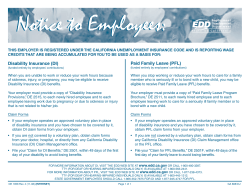
– The World Report on Disability: Implications for Asia and... Symposium University of Sydney, 5-6 December, 2011
Symposium – The World Report on Disability: Implications for Asia and the Pacific University of Sydney, 5-6 December, 2011 Establishing an evidence-base for disability inclusion in eye health programmes Presenter Gail M Ormsby Noela Prasad Manfred Mörchen Te Serey Bonn Ngeth Sarun Evangeline Dunton Myrna Porto Natalie Maggay Nguyen Hong Nga Nguyen Ngoc Anh Jill Keeffe – CBM Australia; Centre for Eye Research Australia – Centre for Eye Research Australia – Takeo Eye Hospital, Cambodia – Takeo Eye Hospital – Takeo Eye Hospital – Takeo Eye Hospital – Takeo Eye Hospital – CBM Viet Nam – CBM Viet Nam – CBM Viet Nam – Centre for Eye Research Australia Cambodia and Vietnam “Disability” inclusive approach to community eye health • Our experience – Gender – Education – Disability • As related to eye health knowledge, attitude and practice • How this informed project implementation Context: Disability Inclusion AusAID strategy for disability inclusion - Development for All: Towards a disability inclusive Australian aid program 2009-2014, – all AusAID funded activities will need to show consideration of disability mainstreaming, – so disability inclusion training and guidelines were included under AusAID Avoidable Blindness Initiative. Field research included Rapid Assessment of Avoidable Blindness (RAAB) and surveys of Knowledge, Attitude and Practice (KAP) to – Provide baseline data on blindness and vision impairment – Provide a picture of the community’s perception of eye health so that the project responds to needs of the community being served. Baseline information Results of RAAB survey Prevalence of vision impairment in people over 50 years of age • Cambodia (conducted in 2007) • Vietnam (conducted in 2010) Region Prevalence of blindness <3/60 Prevalence of severe visual impairment <6/60 – 3/60 Prevalence of moderate visual impairment <6 / 18 – 6/60 Cambodia 2.8 % Viet Nam 3.1 % Son La 2010 1.7 % 1.3 % 7.1 % Thanh Hoa 2011 5.44 % 3.48 % 12.24 % 17.61 % Baseline information Areas of focus for KAP survey Knowledge and attitude of the community regarding their eye health. Current practices and attitudes regarding uptake of eye care services. Perception and practices on the inclusion of women, children and persons with disability in community eye care programmes. Survey Locations Thanh Hoa and Nghe An Provinces Bati Takeo Kiri Vong Sampling Cambodia • 600 people surveyed from across 3 districts 200 people per district • 30 randomly selected villages from across districts 10 villages per district • 20 people surveyed from each village – 6 or 7 people from each age group surveyed from each village (At least 1 or 2 people with a disability) • Random walk to find people – Random lank mark chosen, called in at consecutive houses until number of participants reached – If people with disability not in this sample, convenient sampling used where village leader was asked where person with disability lives (was not found necessary) Vietnam • 4 cities & districts in each province selected according to the following criteria: 2 districts that will be sites of project implementation, 1 urban area where available eye services are linked to the project, 1 district adjacent to site of project implementation. • Quota: people from each district 75% of the total number of respondents in a province from each project district (94 people per district), 15% from urban areas (37 people from each area), 10% from adjacent sites (25 per site). Ensure at least 1 or 2 people with a disability are included at each site. Results Potential service users surveyed 1130 people over 25 years of age • 599 from one province in Cambodia • 531 from two adjacent provinces in Vietnam Men Women Cambodia 214 385 Vietnam 254 277 Education Cambodia Disability Type Seeing Hearing Walking Understanding Other Cambodia Vietnam Total 110 21 33 4 8 174 19 100 39 15 284 40 133 43 23 176 347 523 Vision disability reported in 18% (Cambodia) & 33% (Vietnam) TOTAL 39% (443/1130) of the surveyed population reported SOME disability. Multiple disability Cambodia Vietnam Total Males Females Males Females 61 70 122 133 386 Two ‘disabilities’ 8 5 20 11 44 Three or more ‘disabilities’ 3 2 4 4 13 Single disability 12% (18/149) in Cambodia, and 13% (39/294) in Vietnam reported having more than one ‘disability’. Knowledge: heard about eye conditions Knowledge: know treatment for cataracts Attitude Can a child with Vision Impairment or Seeing Difficulty attend school? Practice: getting eyes examined CAMBODIA 38% of all respondents (142 of the 370 that responded) and 40% of people who reported having a disability (46 of the 116 that responded) VIETNAM 85% of all respondents (354 of the 419 that responded) and 84% of people who reported having a disability (210 of the 249 that responded) said that they ‘went for examination of an eye problem’ Conclusions • Self-reported ‘Disability’ is common among the sampled population. • Inclusive planning can be achieved even without positive discrimination towards persons with disability. – through integration into existing eye programmes – at minimal additional cost • Some people with disability report accessing access eye care services if available. • But people with disability have less access to eye health information. • Evaluation at end of the project period will assess outcomes of a disability inclusive approach to community eye heath programme.
© Copyright 2025









